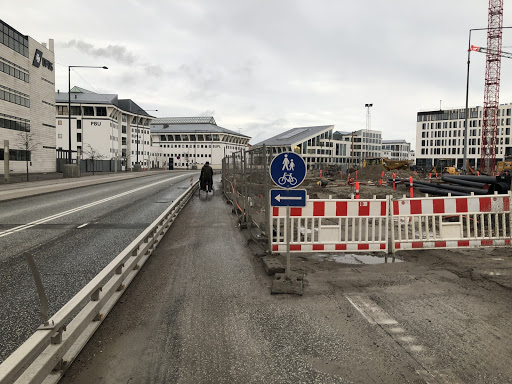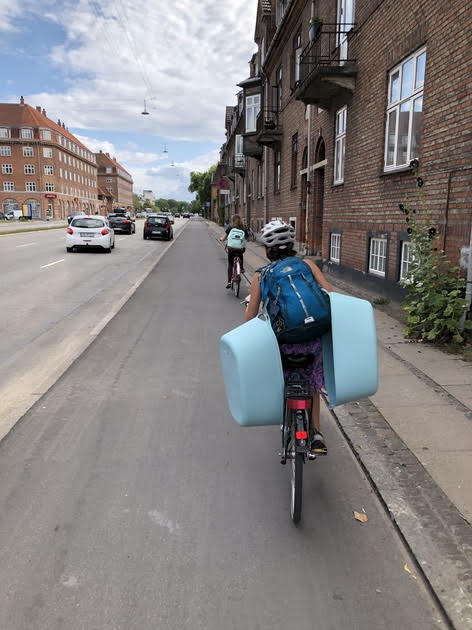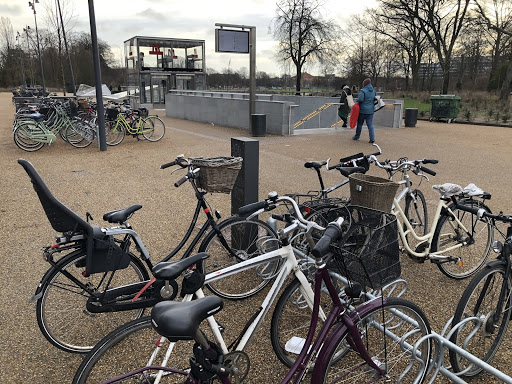Guest blog by Doug Kelley.

Copenhagen is famous for having the world’s best bike infrastructure and highest rates of bike transportation. (OK Amsterdam, you’re not bad, either.) Transit nerds love to extol the engineering details, celebrate the signage, and explain the traffic patterns in excruciating detail. While I admit getting excited by those nerd-outs — I’m an engineering professor and a lifelong cyclist, after all — the real point is the beautiful lifestyle enabled when communities “Copenhagenize.” So here’s a snapshot, one typical day of the lifestyle, as lived by my family and me during our sabbatical year away from Rochester.

After a Danish breakfast of pastries, yogurt, and coffee, I hop on my bike for the morning commute. Neighborhood roads bring me to Lyngbyvej (pronounced “loong boo vye”), busy at rush hour with more car traffic than almost any road in central Copenhagen. Still, it’s a pleasant place to cycle, because its wide bike lanes are separated from the cars by curbs, and because automotive traffic is held to reasonable speeds by stoplight timing and posted limits. At rush hour, Copenhagen’s roads carry more bikes than cars, so I feel like part of the crowd. Some cyclists ride slower, and some ride faster, passing on the left, often after ringing their bells to avoid surprises. (Impatient commuters sometimes ring excessively.) As I head south, motorists turning right wait at the intersection for a gap in the long line of cyclists passing in their own lane.
From experience I know that the stoplight at Tagensvej (pronounced “tah gens vye”) is slow, so seeing its pedestrian signal turn green up ahead, I pedal harder. A green bike signal comes next, then a green signal for motorists. I sail through as the bike signal turns yellow. Arriving at work in under 10 minutes after a 1.5-mile ride, I’m invigorated and just starting to warm up. Bike parking is ample, with spots in the open by the nearby entrance, covered spots further away, and beyond them, an underground bike-only parking deck for bad weather and expensive bikes. Most folks ride commuter bikes, akin to what Americans might call hybrids, neither flashy nor expensive, just practical. I pull into a covered spot.

Meanwhile my younger daughter, age 12, sets out for school, also biking. She soon turns left from Lyngbyvej, using the usual jug-handle method: ride across the intersecting street, stop until the signals change, then ride left across Lyngbyvej and on toward school. That keeps her in the bike lanes all the time, so she doesn’t have to change lanes and cut across motor traffic. Like the Danes, she gives a hand signal beforehand. A few blocks later, road signs direct her through a slight detour. Construction is blocking the usual bike lane, so the motor-vehicle lanes have been narrowed to make room for bikes and pedestrians, protected by a steel barrier. Construction is no excuse to block important bike and pedestrian thoroughfares.
Copenahgen may have the world’s highest rates of bike transportation, but it doesn’t have the world’s best weather. Today it’s drizzling, so my daughter is wearing a shell jacket, boots, and her new waterproof pants. Danes like to say there is no bad weather, only bad clothing. Sure enough, rain hardly changes the number of cyclists on the road, and today the nearby cyclists wear clothing varying from Gore-Tex to full-body ponchos to soggy blue jeans. Most of their bikes have fenders, and lights are required by law–winter nights in Denmark are long.

Having stuff to carry doesn’t keep people from cycling, either. I take my laptop and lunch to work in waterproof saddle bags. My daughter carries a backpack, like many of the riders around her. Nearly all their bikes have racks on the back, often bearing loads held with bungee cords. Mail, football equipment, take-out, Ikea furniture, and all manner of things get carted around on sturdy flatbed cargo bikes, sometimes with electrical assistance to make pedaling easier. Danish parents commonly carry their kids to school in cargo bikes with boxed compartments on the front. Older kids sit on tag-along bikes attached to mom’s or dad’s. Most have learned to ride solo by age 3 or 4, and are getting to school on their own bikes by age 6 or 7.

My older daughter, age 13, isn’t a morning person and leaves later, finishing her 2.2-mile commute and parking her bike just in time for class. After school, the clouds persist but the rain has quit, so she decides to bike with classmates to Stroget, one of the largest pedestrian-only market streets in Europe, to window-shop and buy some candy to share. As her dinnertime curfew approaches, she considers the headwinds and decides not to bike all the way home, instead catching the S-train, which allows bikes anytime. Metro trains also allow bikes, though not at rush hour, and only with an extra ticket. But she might be tempted to take the Metro anyway once the new Orientkaj stop opens–it’s next-door to her school.

While the rest of us are away, my wife shops for some hygge (cozy) furnishings at the neighborhood secondhand shop, then picks up groceries for dinner, including fresh-baked bread. She could bike both places, but decides to walk for exercise, and anyway the grocery store is only three blocks from our apartment. After working at home awhile, she rides the S-train to Klampenborg to jog in the woods. In summer, she might instead bike to the Nordhavn harbor for a swim, or cycle 25 miles to Helsingør, then ride the train home. Neither she nor I need to plan our day around driving our kids from place to place, since they can capably bike and navigate public transportation on their own.
Home together at the end of the day, the four of us light candles, start a fire in the wood stove, and sit down to dinner. My younger daughter is ravenous after biking home from football (pronounced “soccer”) practice. My older daughter is proud that her new fitness tracker logged 14,000 steps since the morning. We have lived another day of our full and busy lives, traveling to work and school and many other places without driving a car or wishing for one. Our daily travels have required nearly no fossil fuel and put nearly no carbon into the atmosphere. Outdoor exercise lifts our moods and keeps us fit. Alternative transportation gives the kids freedom to move about independently, making extra time for us parents. And in the summertime, when the days are long and the skies are clear, Copenhagen transportation is even more lovely.

Crucially, you don’t have to live in Copenhagen to enjoy this lifestyle. Ride RTS. Rent a Pace bike. Stroll to your neighborhood cafe. Bike to work and to the Public Market. Though Rochester’s bike infrastructure doesn’t match Copenhagen — nobody’s does — you can bike to many destinations without using big, ugly roads clogged with motorists. Pedal on the Canal Path, on the River Trail, on the cycle tracks along Union Street or Elmwood Avenue, on the network of Bike Boulevards, or simply on quiet streets that parallel the big thoroughfares. Teach your kids to bike, show them safe and effective routes, let them walk, and teach them to use public transportation. Tell community leaders about the importance of building alternative transportation infrastructure. And support organizations like Reconnect Rochester that are enlarging this lifestyle in Rochester.


Helmets? I see some in the photos. Is that just the Americans, or do some Danes wear helmets?
Great post Doug! Spent some time in CPH last summer and our experiences were very similar – no qualms whatsoever about the kids riding bikes on busy roads (versus here where we actively stick to side streets).
The crazy thing that I think a lot of people don’t “get” about Denmark… it’s not that there are no cars. You can drive if you want (and indeed we rented a car to go visit Funen and Jutland), and it’s not that expensive. It’s just a whole lot easier to get around by bike for day to day things, such that owning a car in a city like CPH becomes a liability.
About helmets: some Danes wear them, and some don’t. Some instead wear a gizmo I’ve never seen in the US, an airbag-collar (many made by Hövding, in case you’re curious).